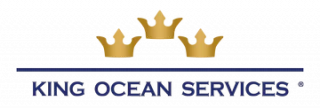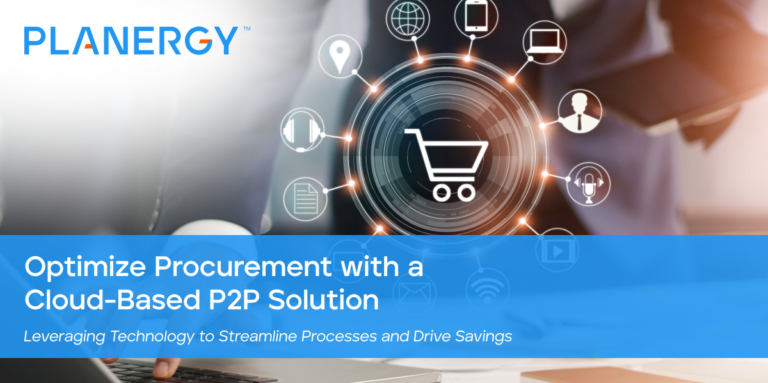Procurement transformation is at the forefront of modern business strategy.
For procurement leaders and CFOs, optimizing procurement processes can lead to cost savings, efficiency, and competitive advantage.
One of the most impactful ways to achieve this is by adopting a cloud-based Procure-to-Pay (P2P) solution.
What is Procure-to-Pay?
Procure-to-pay (P2P) is a comprehensive process encompassing all activities in procuring goods and services from external suppliers and managing the payment processes.
It starts with identifying a need for goods or services within an organization, includes the procurement steps such as requisitioning, purchasing, receiving, and invoicing, and ends with the final payment to the supplier.
The key stages of a P2P process typically include:
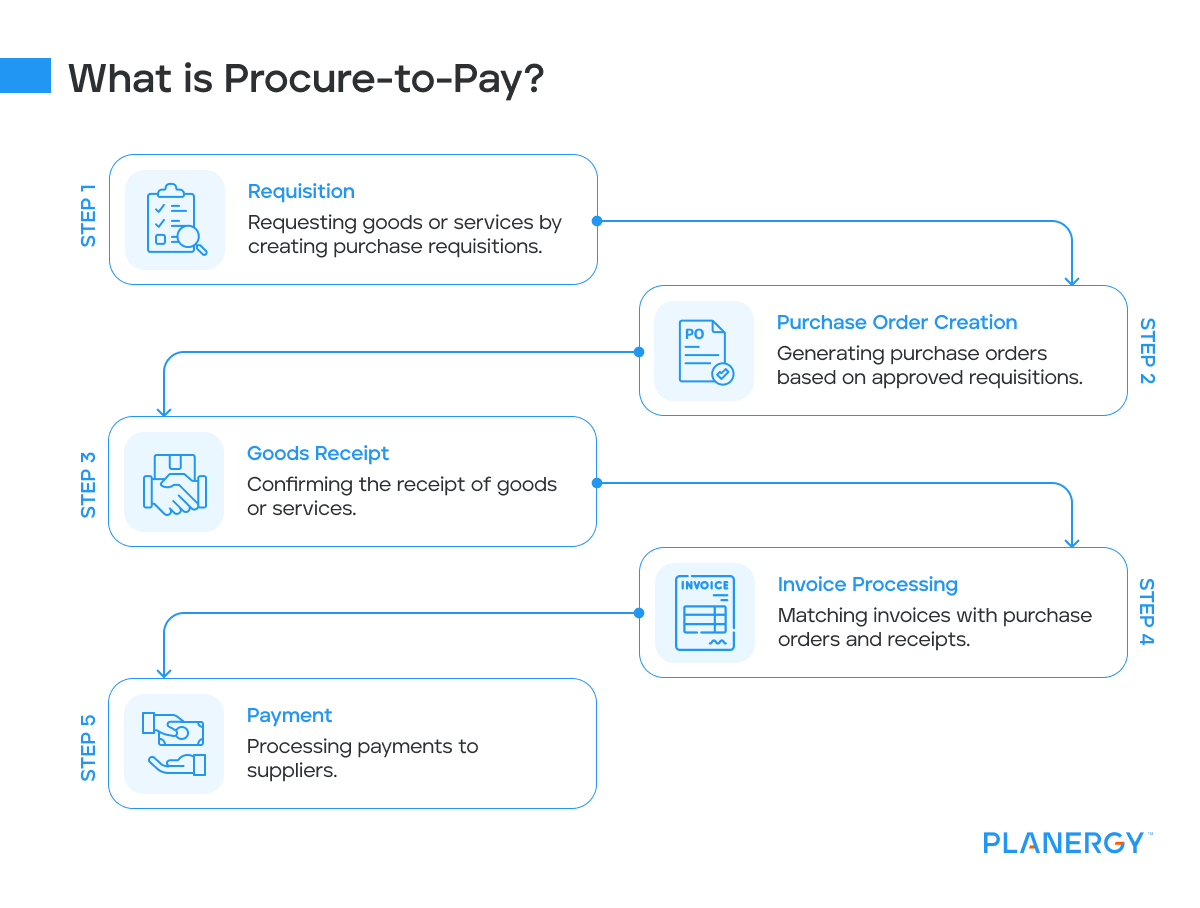
- Requisition: Requesting goods or services by creating purchase requisitions.
- Purchase Order Creation: Generating purchase orders based on approved requisitions.
- Goods Receipt: Confirming the receipt of goods or services.
- Invoice Processing: Matching invoices with purchase orders and receipts.
- Payment: Processing payments to suppliers.
What is a Cloud-Based P2P Solution?
A cloud-based procure-to-pay solution streamlines the procurement process by automating the entire lifecycle from requisition to payment.
By leveraging cloud technology, you can manage procurement activities through a centralized, digital platform accessible from anywhere.
This is more cost-effective and directly impacts your bottom line by improving procurement performance.
Benefits of Cloud-Based Procure-to-Pay Software
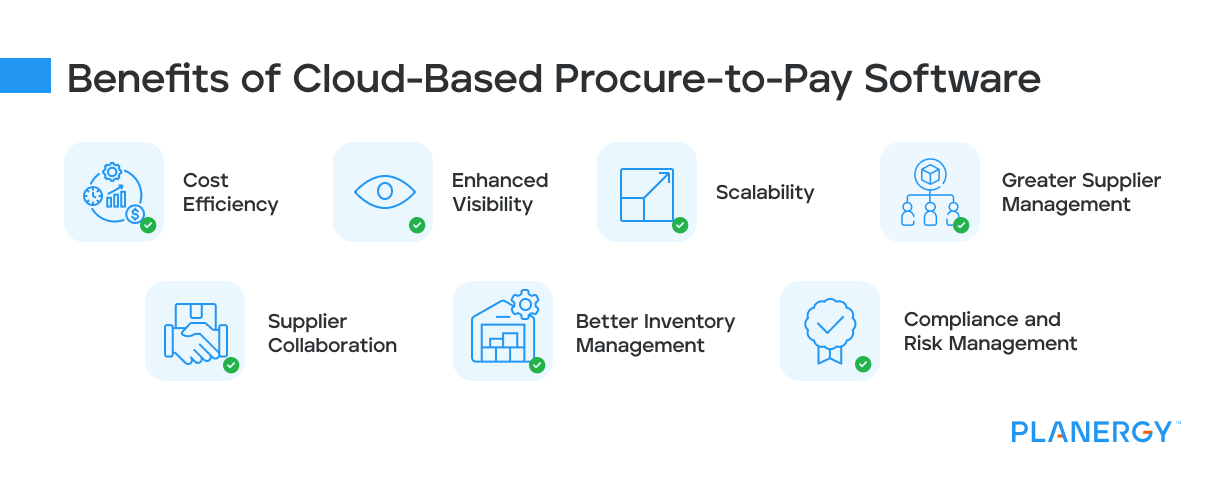
Cost Efficiency
Reduce manual labor, errors, and administrative costs.
Implementing advanced procurement solutions can save significant costs by automating routine tasks such as purchase order creation, invoice processing, and data entry.
Automation minimizes human errors that often result in costly discrepancies and rework.
Streamlined processes reduce the need for extensive administrative support, allowing you to allocate resources more effectively.
Enhanced efficiency lowers operational costs and accelerates the entire procurement cycle, from requisition to payment.
Enhanced Visibility
Real-time tracking and reporting improve transparency across the procurement cycle.
With advanced procurement systems, you gain comprehensive visibility into every stage of the procurement process.
Real-time tracking allows you to monitor the status of orders, deliveries, and payments, providing a clear view of your procurement activities.
Detailed reporting tools offer insights into spending patterns, supplier performance, and compliance metrics, enabling informed decision-making.
This transparency fosters accountability and helps identify opportunities for further optimization and cost savings.
Scalability
Quickly scale your operations without significant investment in IT infrastructure.
Modern cloud-based procurement solutions provide the flexibility to scale up or down based on your business needs.
As your organization grows, these solutions can accommodate increased transaction volumes, additional users, and expanded supplier networks without requiring substantial investments in new hardware or IT support.
This scalability ensures that your procurement operations remain efficient and effective regardless of changes in demand or organizational structure, supporting long-term growth and resilience.
Compliance and Risk Management
Automated checks and balances ensure adherence to procurement policies and regulations.
Maintaining compliance with internal policies and external regulations is critical for mitigating risks and avoiding legal repercussions.
Advanced procurement systems incorporate automated compliance checks that validate transactions against predefined rules and standards.
These systems also facilitate risk management by providing tools for supplier evaluation, contract management, and audit trails.
Ensuring that all procurement activities adhere to established guidelines can reduce the likelihood of non-compliance and enhance overall governance.
Greater Supplier Management
Depending on your industry, it’s possible you could have a long list of suppliers to manage across your entire supply chain.
Having all the suppliers set up in your procurement system makes it easier to store catalogs and keep track of which suppliers are making the biggest impact on your business.
You can keep track of how many orders you’re placing with vendors, so you can leverage the information when it comes time to negotiate a new contract.
You can also see which suppliers you don’t use, or the ones that present problems for your company, so you know when it’s time to find a replacement.
Supplier Collaboration
You’ll get improved communication and collaboration with suppliers through a unified platform. Strong supplier relationships are essential for a resilient and efficient supply chain.
Unified procurement platforms enable seamless communication and supplier collaboration, fostering better partnerships.
Features like shared portals, real-time updates, and integrated workflows help streamline interactions, from order placement to delivery confirmation.
Enhanced collaboration leads to improved alignment of expectations, quicker issue resolution, and greater overall efficiency.
You can achieve better terms, higher quality, and more reliable supply chains by building stronger supplier relationships.
Better Inventory Management
Keeping a close eye on your inventory levels is crucial to maintaining the budget and cash flow, customer satisfaction, and more.
If you have too much inventory in the warehouse, you’ve got capital tied up, and it could easily go bad before it’s sold.
If you don’t have enough inventory, you may need to slow down or halt production, which creates issues for customers.
With the audit trail, you can see who’s taken what action on each order and invoice.
This prevents duplicate orders to avoid having too much of one thing and not enough of another.
How Do Cloud-Based Software Solutions Work?
These solutions integrate with existing ERP systems to automate procurement activities.
Once integrated, data is synchronized so that all procurement data is updated in real time to proven data silos and ensure consistency across the entire organization.
Key functionalities include:
Requisition Management
Cloud-based P2P solutions automate and streamline the creation and approval of purchase requisitions.
This functionality enables businesses to process requisitions quickly and accurately, reducing delays and improving efficiency.
By integrating with existing ERP systems, these solutions can pull data directly from inventory, budgeting, and supplier records, ensuring that all requisitions are well-informed and compliant with company policies.
Automated workflows route requisitions to the appropriate approvers, significantly speeding up the approval process and reducing manual errors.
Purchase Order Management
The purchase order management feature of cloud-based P2P solutions allows companies to generate, track, and manage purchase orders automatically.
This functionality is essential for maintaining accuracy and control over purchasing activities.
By automating the generation of purchase orders based on approved requisitions, businesses can ensure that orders are accurate and timely.
Tracking capabilities provide real-time visibility into the status of each purchase order, allowing users to monitor fulfillment progress and address any issues proactively.
This reduces the risk of delays and ensures suppliers are held accountable for their commitments.
Invoice Processing
Invoice processing within cloud-based P2P solutions automates invoice matching, approval, and payment.
This functionality streamlines accounts payable processes by reducing the need for manual data entry and minimizing errors.
Invoices received from suppliers can be automatically matched against purchase orders and receipts, ensuring that discrepancies are identified and resolved promptly.
Automated approval workflows ensure that invoices are reviewed and approved by the appropriate stakeholders, while integration with financial systems facilitates timely and accurate payments.
This leads to improved supplier relationships and optimized cash flow management.
Spend Analysis
Spend analysis is a crucial component of cloud-based P2P solutions that gives businesses insights into spending patterns.
By analyzing procurement data, companies can identify trends, opportunities for cost savings, and areas where you can optimize spending for better overall spend management.
This functionality leverages advanced analytics and reporting tools to categorize and visualize spending across various dimensions, such as suppliers, categories, and departments.
With these insights, businesses can negotiate better terms with suppliers, enforce compliance with purchasing policies, and make data-driven decisions to improve overall procurement efficiency and effectiveness.
Why Choose Cloud-Based Procurement Software Over Manual P2P?
Manual business processes are often fraught with inefficiencies, errors, and lack of visibility. Cloud-based solutions offer:
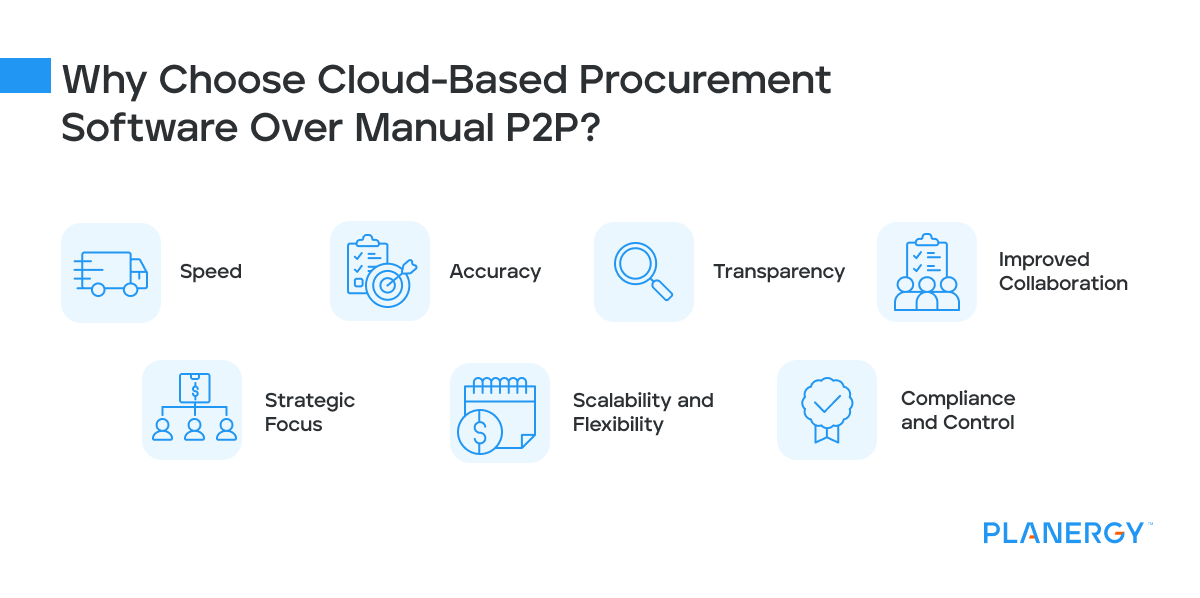
Speed
These solutions automate the entire procure-to-pay process, eliminating manual steps that often cause delays.
Requisition approvals, purchase order generation, and invoice processing can be completed in a fraction of the time compared to traditional methods.
This acceleration enhances operational efficiency and ensures that goods and services are procured and paid for promptly, leading to better supplier relationships and uninterrupted business operations.
Accuracy
Manual data entry and paper-based processes are prone to mistakes, leading to discrepancies, delays, and financial losses.
Automation reduces the likelihood of human error by ensuring that data is accurately captured, processed, and verified at each step of the procurement cycle.
This increased accuracy helps maintain data integrity, reduces the need for rework, and ensures compliance with organizational policies and regulatory requirements.
Transparency
With real-time access to procurement data, you can gain valuable insights into your spending patterns, supplier performance, and process efficiencies.
Dashboards and analytics tools provide a clear view of critical metrics and trends, enabling procurement teams to make informed decisions quickly.
This transparency also fosters accountability and trust among stakeholders, as everyone can access the same accurate and up-to-date information.
Improved Collaboration
Integration enhances collaboration between procurement and other departments, such as finance and accounting.
With shared access and up-to-date procurement data, these departments can work together more effectively, regardless of their physical locations.
With real-time updates on the status of orders, approvals, and payments, there’s better coordination and responsiveness.
Strategic Focus
Freeing procurement teams to focus on strategic activities rather than administrative tasks is a crucial benefit of cloud-based P2P solutions.
By automating routine and repetitive tasks, such as requisition approvals, purchase order generation, and invoice processing, these solutions allow procurement professionals to allocate more time and resources to strategic initiatives.
This shift enables teams to concentrate on activities that add greater value to the organization, such as supplier relationship management, contract negotiations, and strategic sourcing.
Ultimately, this leads to improved procurement outcomes and a stronger competitive advantage for the business.
Scalability and Flexibility
Cloud-based P2P systems offer scalable solutions that can grow with the organization.
They provide flexibility in managing procurement processes and easily adapting to changing business needs while maintaining integration with the ERP system.
Compliance and Control
Integrated P2P and ERP systems help maintain compliance with organizational policies and external regulations.
They provide tools for budget control, guided spending, and audit trails, ensuring that procurement activities adhere to set standards.
Reasons Why Manual Procure-to-Pay Systems Are Not Good for Your Organization
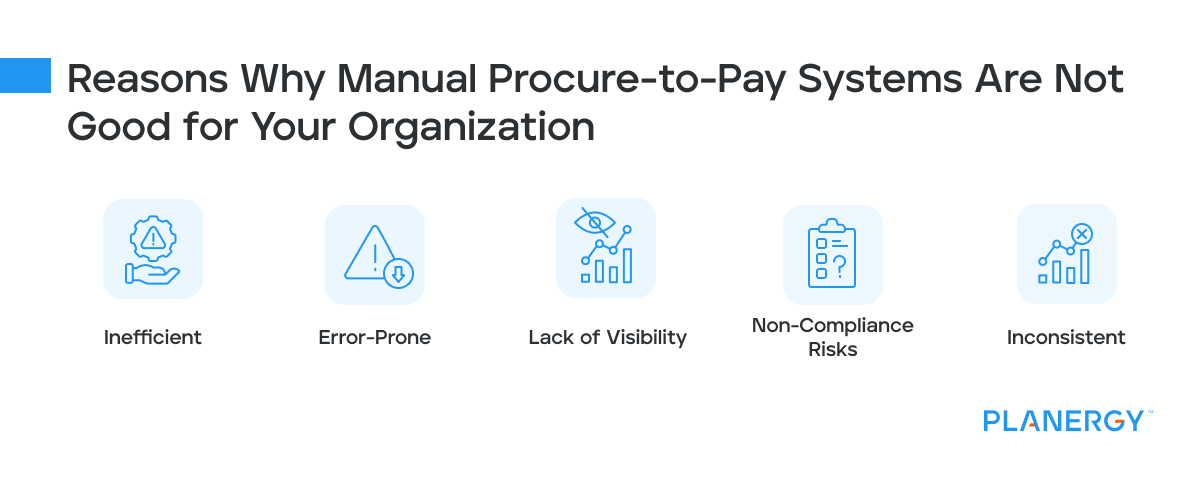
Inefficient
Manual processes are slow and cumbersome, leading to delays in procurement cycles.
They also require significant manual effort, increasing labor costs and diverting resources from more strategic tasks.
Error-Prone
Manual data entry is susceptible to errors, such as incorrect order quantities or pricing.
Physical documents can be lost or misplaced, causing delays and inaccuracies.
Lack of Visibility
With limited access to data, it can be difficult to obtain real-time information, hindering effective monitoring and decision-making.
Manual systems lack robust reporting capabilities, making it challenging to analyze spend and performance.
Non-Compliance Risks
Enforcing procurement policies and compliance with regulations is more difficult.
Maintaining a complete and accurate audit trail also complicates audits and reviews.
Inconsistent
Different people may follow different procedures, leading to inconsistencies and inefficiencies.
There could be confusion and errors without standardized processes for handling procurement tasks.
Why You Need an All-in-One P2P Platform
Streamlined Processes
A unified workflow combines procurement activities into a single platform to ensure consistency and efficiency.
End-to-end automation automates the entire procure-to-pay cycle, not just the purchasing process, reducing manual touchpoints and speeding up processes.
Centralized Data Management
A single source of truth provides a comprehensive view of all transactions and supplier interactions.
Improved analytics facilitates advanced analytics and reporting, enabling better insights and decision-making.
Cost-Efficiency
Investing in a cloud-based solution lowers operational costs by eliminating the need for multiple disparate systems.
It offers scalable solutions that can grow within the organization, avoiding the need for costly system replacements.
User-Friendly Interface
An easy-to-use platform provides an intuitive and user-friendly interface, reducing the learning curve and increasing user adoption.
Mobile accessibility supports mobile access, allowing procurement tasks to be performed on the go, enhancing flexibility and productivity.
Make the Switch to the Cloud Today
Adopting a cloud-based procure-to-pay (P2P) solution is a strategic move that can revolutionize your organization’s procurement processes.
By automating manual tasks, ensuring real-time data visibility, and fostering better supplier relationships, a cloud-based P2P system brings significant cost savings and operational efficiencies.
Furthermore, it enhances compliance, reduces errors, and provides scalable solutions that grow with your business needs.
To remain competitive and drive procurement excellence, it’s time to move away from outdated, manual processes and embrace the transformative power of a cloud-based P2P platform.
Take action today by evaluating your current procurement system and considering the integration of a comprehensive, cloud-based P2P solution to streamline operations and achieve sustainable growth.
